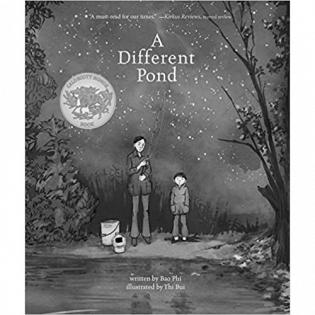A Different Pond Literature Guide
Inspired by the real-life stories of author Bao Phi and illustrator Thi Bui, this beautifully crafted picture book tells the story of a simple event in the life of an immigrant family. Phi’s poetic tale invites the reader to join the boy and his father on a fishing trip. This semi-autobiographical tale celebrates the perseverance and sacrifice of immigrant families.
Literature Guide by Maureen Klein
Before Reading
Ask: The family in the story immigrated from Vietnam, a country in Southeast Asia. What does it mean to be an immigrant?
Show: Look at the image on the cover of the book. What do you notice about the boy and his father? Look closely at the faces of the characters throughout the book to learn more about how the boy and his father are feeling.
Connect: A Different Pond is a story about a family. As you read, watch for ways the family is similar to or different from your own family.
During Reading
Connect: A kid at the boy’s school made fun of how his dad talked. The kid said his dad’s English “sounds like a thick, dirty river.” How do you think that made the boy feel? What is a more respectful way to talk or ask about someone's language difference or accent?
Ask: Why are the boy and his father going fishing? How will their successful trip help their family? How does the boy feel about helping?
Show: Pause at the page in which Dad talks about fishing in a pond like this back in Vietnam. Look closely at their faces. Describe how you think Dad and the boy feel about Vietnam and their experiences with war and moving.
After Reading
Ask: This book is told from the perspective of the boy. How might it have been different if it was told from the perspective of the father? The author said his parents talked about the hard times they experienced with the children of their family. How might that help the children?
Show: Look at the picture of the boy waving goodbye to his mom toward the end of the book. Describe how the boy feels about his parents working several jobs. Describe a time you felt proud to help.
Connect: At the end of the day, the family gathers around the dinner table. In what ways are your family meals similar to or different from the boy's?
Activities
-
Use Learning to Give’s Oral History Project to explore family immigration stories while developing respect and empathy through generous listening.
-
Reflect on what was important to the family in the story and compare that to what is important to your own family. In the shape of two ponds, create a Venn Diagram with words or pictures that compare and describe meaningful details of the boy's family and your own. What attributes do you have in common with the boy and his family?
-
Read the end note from the illustrator. Thi Bui included images of things from her childhood in the illustrations of this book. Choose a special family item that is in your home and tell its story. Draw a picture of your home including special family items in your illustration.
-
A Different Pod is dedicated to refugees everywhere. Watch the video “Who is a Refugee?” from the UN Refugee Agency. Research what your school or community is doing to support refugees in your area and how you can support their work.
-
Learn about the difference between an immigrant and a refugee in Learning to Give's Cultural Competency Guide activity Immigration and Refugees.
